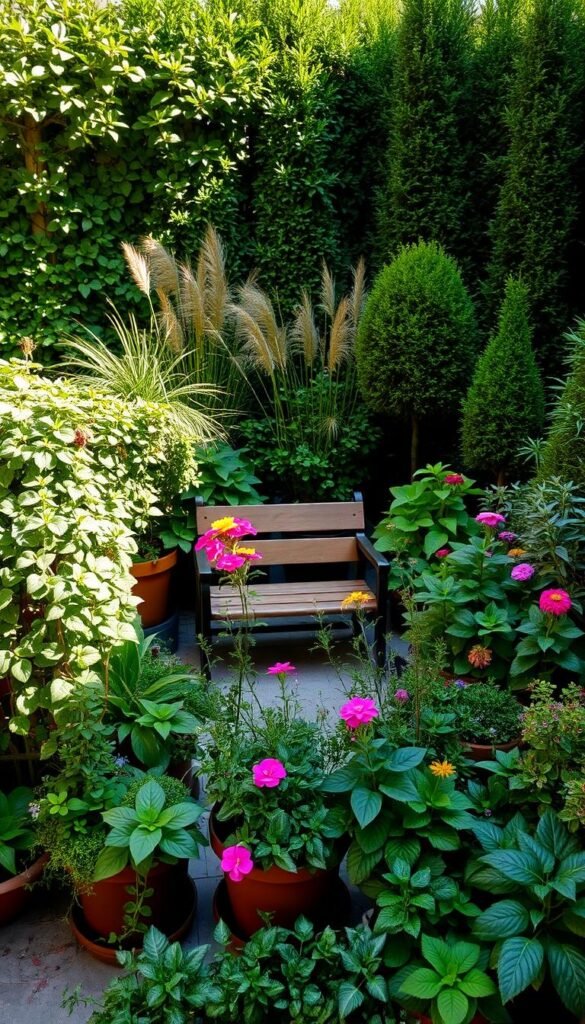Transforming tight outdoor areas into vibrant retreats requires clever planning and imaginative thinking. Even the coziest balcony or narrow patio can become a refreshing escape when you apply strategic design principles that prioritize both beauty and function.
Start by assessing your area’s unique features—like sunlight patterns and existing structures. Curved pathways and vertical planting systems work wonders for adding depth, while clustered containers create lush focal points without overcrowding. For inspiration, explore how cottagecore-inspired details blend practicality with whimsical charm.
Layered textures, such as trailing vines paired with compact shrubs, make every inch feel intentional. Opt for low-maintenance plants like sedum or coneflowers to keep upkeep simple. Remember, smart zoning helps separate relaxation spots from growing areas, ensuring your retreat remains organized yet inviting.
With thoughtful layouts and creative touches, even modest spots can radiate personality. Let’s dive into techniques that turn constraints into opportunities for crafting your own slice of paradise.
Understanding Your Small Garden Space
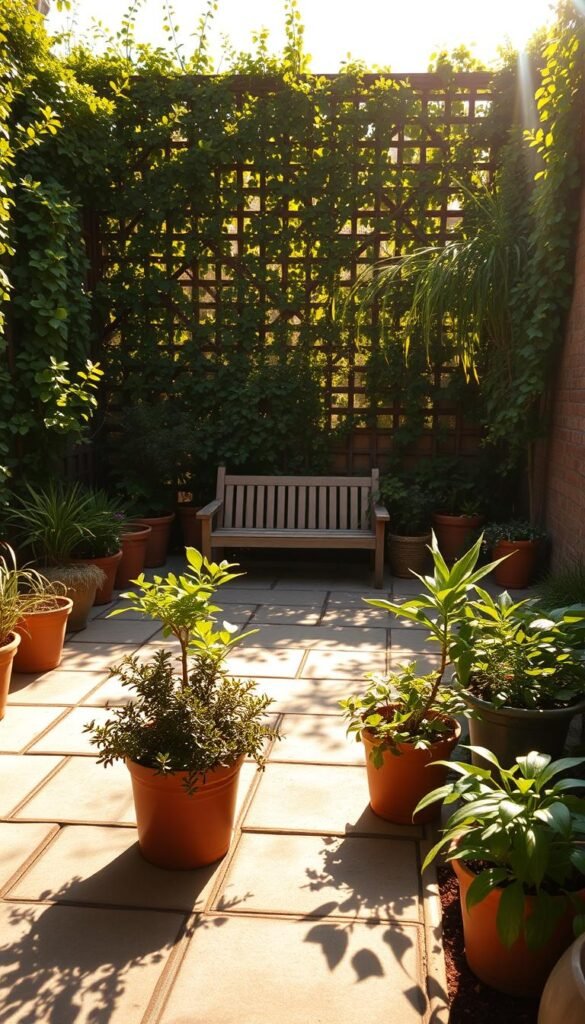
Unlocking your outdoor area’s full charm starts with becoming a sunlight detective. Track how rays move across your plot during different seasons – you’ll spot patterns that determine what thrives where. Morning light often differs from harsh afternoon beams, creating micro-environments perfect for specific plants.
Assessing Sunlight and Layout
Grab a notebook and record light conditions three times daily for a week. Notice how structures like fences or buildings create shade pockets. Remember:
- Summer sun sits higher than spring/fall positions
- South-facing walls absorb heat for warmth-loving plants
- Paved surfaces reflect light, creating “hotspots”
This table helps match plants to your findings:
| Light Type | Daily Hours | Plant Examples |
|---|---|---|
| Full Sun | 6+ | Lavender, Rosemary |
| Partial Sun | 4-6 | Hydrangeas, Ferns |
| Shade | <4 | Hostas, Bleeding Hearts |
Identifying Your Garden Zones
Divide your area into functional sections based on light data and usage needs. A sunny corner could become an herb spiral, while shaded nooks might host a moss garden. Wind-protected spots near walls are ideal for delicate blooms.
For more design strategies, explore our guide on elevating your gardening aesthetic. Documenting these zones helps create a cohesive layout where every plant has its perfect home.
Inspiring Garden Ideas for Compact Outdoor Areas
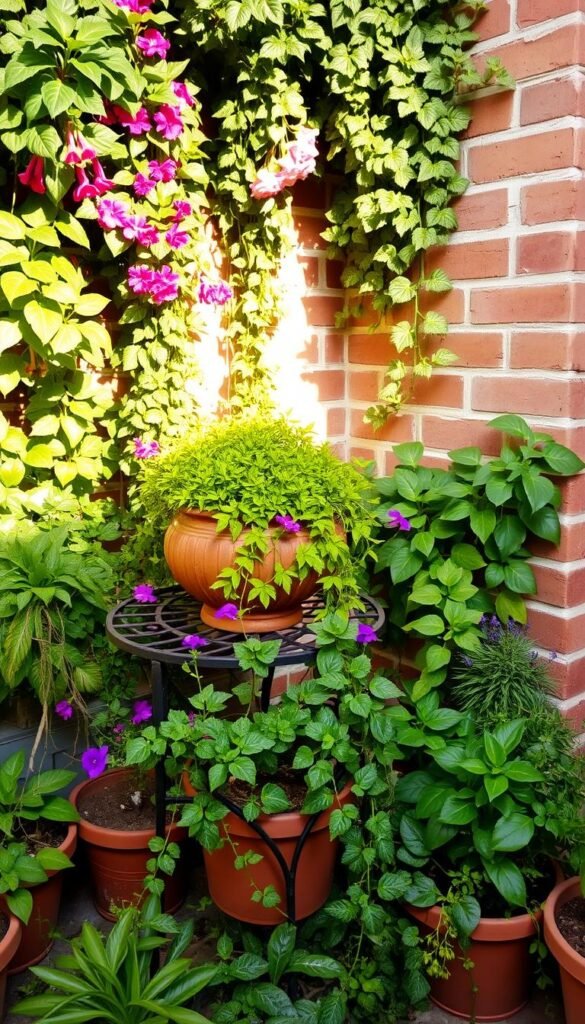
Your outdoor space becomes a personalized retreat when infused with creativity. Start by exploring styles that resonate with you—maybe crisp geometric patterns or wild cottage charm. Visiting local botanical displays or browsing DIY garden art projects sparks fresh ideas for blending function with artistry.
Creative Plant Arrangements
Think vertically! Tall grasses behind mid-height flowers, with trailing ivy spilling from shelves, create depth. Try the “thriller, filler, spiller” method:
- Thriller: Eye-catching centerpiece (e.g., dwarf Japanese maple)
- Filler: Bushy plants (like begonias) for fullness
- Spiller: Cascading varieties (such as creeping thyme)
Group plants in triangular clusters to guide the eye naturally. This trick works wonders on balconies or narrow patios.
Using Color and Texture Effectively
Cool-toned blues and purples make tight spots feel airy, while warm reds add cozy energy. Pair velvety lamb’s ear with spiky succulents for tactile contrast. For year-round appeal, mix evergreen shrubs with seasonal bloomers like pansies or asters.
Pro tip: Repeat two key colors across your garden to unify the design. A monochromatic scheme with varying textures keeps it dynamic without overwhelming the senses.
Small Garden Aesthetic: Making the Most of Limited Space with Lush Details
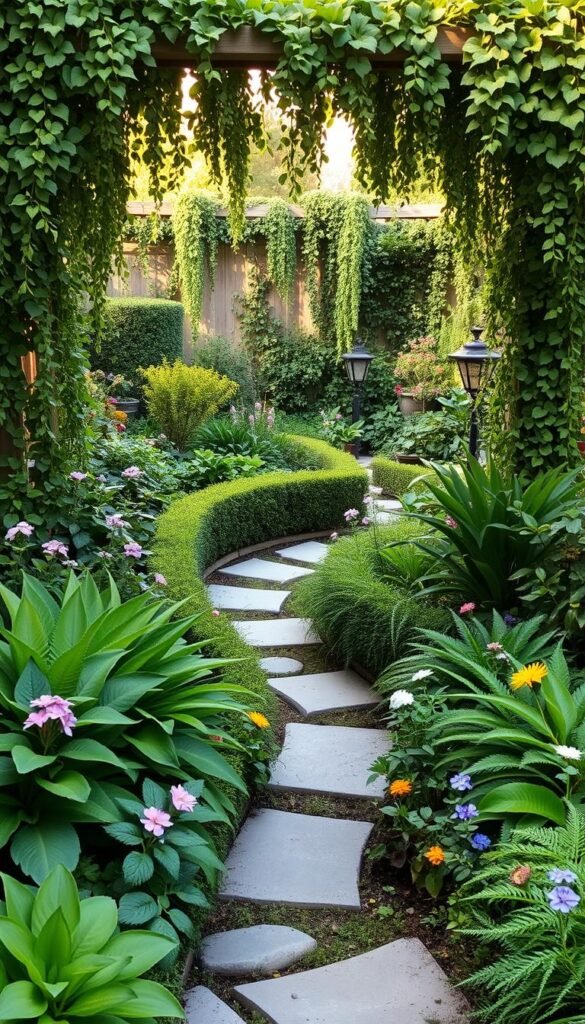
Maximizing visual impact in petite plots starts with strategic placement and borrowed scenery. Think like a painter—every shrub, bloom, and pathway becomes a brushstroke that shapes your outdoor canvas. Vertical layers draw the eye upward, while clustered foliage adds richness without clutter.
Combine tall grasses with mid-height perennials and creeping groundcovers to fake depth. This table shows how plant heights work together:
| Layer | Height Range | Role | Examples |
|---|---|---|---|
| Canopy | 6-8 ft | Vertical interest | Dwarf cherry, columnar evergreens |
| Mid-Level | 2-4 ft | Color/texture | Hydrangeas, salvias |
| Groundcover | <1 ft | Unify spaces | Sedum, ajuga |
Borrow views beyond your fence—a distant tree or neighbor’s flowering vine becomes part of your scenery. Repeat key plants in pots and beds to tie everything together. Evergreen shrubs like boxwood give structure, while seasonal stars like asters keep things lively.
Create cozy nooks using arbors or tall planters as natural dividers. For more inspiration, check out these creative gardening ideas that turn limitations into design superpowers. Remember: three-season interest beats fleeting blooms. Pair spring bulbs with summer grasses and winter berries for year-round charm.
Container Gardening for Maximum Impact
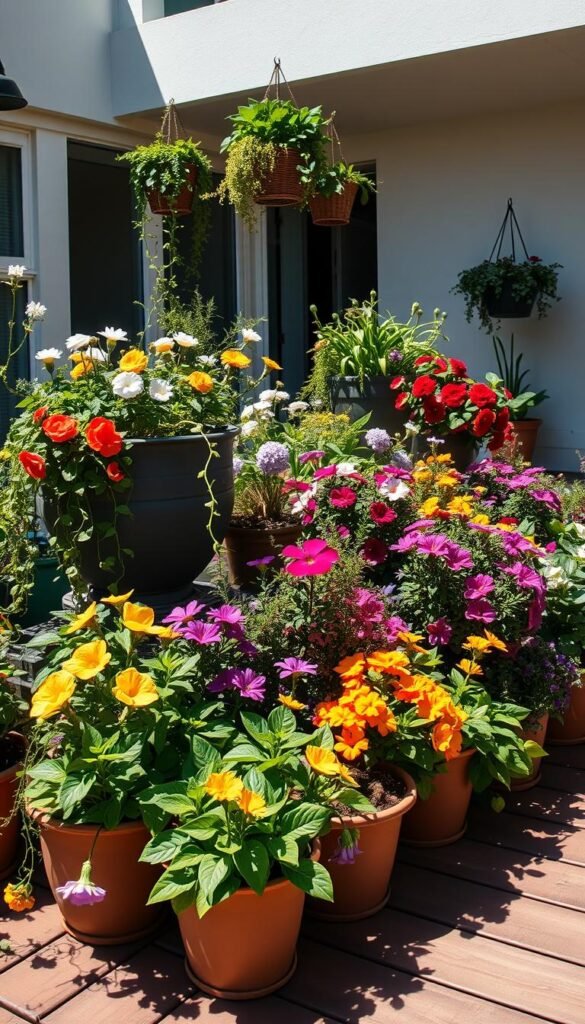
Unleash your green thumb potential with containers that transform overlooked spaces into blooming hotspots. Whether you’re working with a fire escape or a narrow porch ledge, portable planters let you curate vibrant displays wherever sunlight peeks through.
Choosing the Right Pots and Materials
Size matters more than you think. A 12-inch diameter works for most herbs, while tomatoes need 18+ inches. Match materials to your climate:
- Terracotta: Breathable clay prevents soggy roots but dries faster
- Resin: UV-resistant and lightweight for windy balconies
- Fabric: Air-prunes roots naturally, preventing circling
Double potting lets you swap seasonal stars quickly—place plastic liners inside decorative containers for instant refreshes.
Watering and Drainage Best Practices
Those holes at the bottom? Non-negotiable. Elevate pots with feet or gravel to prevent waterlogging. Self-watering systems with reservoirs keep soil evenly moist—perfect for vacations or busy schedules.
Mix perlite into potting soil for better drainage. Check moisture by sticking your finger 2 inches deep. If it’s dry, water slowly until it runs through the base. For vibrant container arrangements, feed plants every 2-3 weeks with balanced liquid fertilizer.
Embracing Raised Bed Gardening Techniques
Elevate your planting game with raised beds—a smart solution that combines the depth of traditional plots with container flexibility. These elevated growing spaces let you cultivate more plants than pots while maintaining precise soil quality and drainage control. Raised garden setups work particularly well for urban spaces, turning cramped yards into productive green zones.
Building durable beds starts with material selection. Cedar and galvanized steel resist rot, while composite lumber offers lightweight durability. Aim for 12-18″ heights to accommodate root systems while reducing back strain. Consider these construction essentials:
- Line bottoms with hardware cloth to deter burrowing pests
- Space beds 24-36″ apart for easy access
- Use corner brackets for added stability
Fill your raised beds with a 50/30/20 mix of topsoil, compost, and perlite for optimal nutrition and drainage. This blend supports everything from juicy tomatoes to fragrant lavender. Mulch with straw or shredded bark to lock in moisture and suppress weeds—critical for protecting perennial roots during frosty months.
For those working with compact areas, tiered designs add visual depth while maximizing yield. Arrange taller plants like pole beans at the back, with herbs and flowers cascading forward. The elevated height means less bending, making watering and harvesting a breeze.
Window Box Gardening to Enhance Curb Appeal
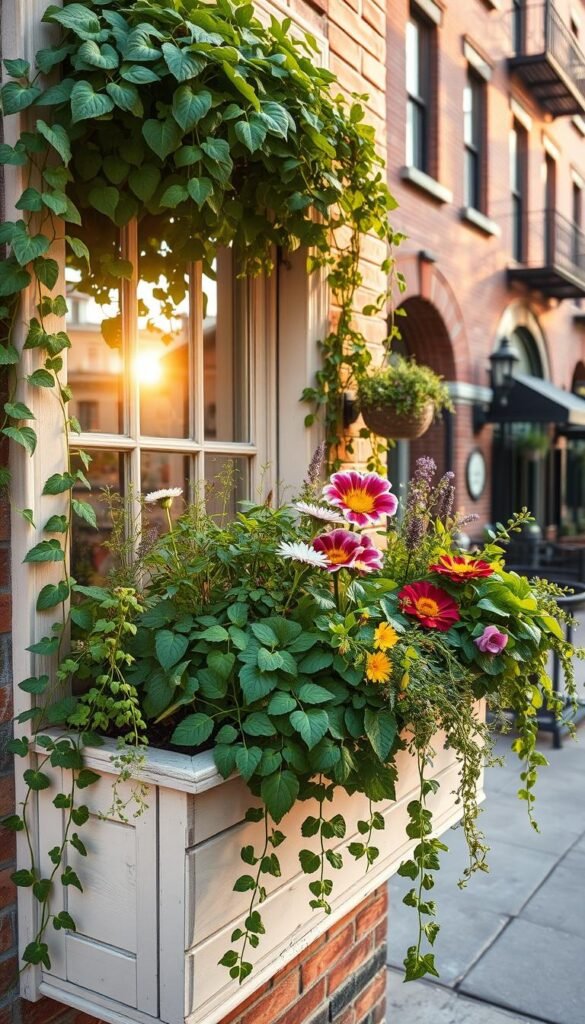
Breathe life into your home’s exterior with window boxes that blend charm and utility. These versatile planters turn blank walls and railings into blooming masterpieces, offering fresh herbs or vibrant flowers just steps from your kitchen or patio.
Ideal Plants for Window Boxes
Choose greenery that thrives in shallow soil and matches your light conditions. Compact herbs like oregano and chives flourish in sunny spots, while trailing lobelia adds color to shaded areas. Consider these factors:
- Mature size: Dwarf varieties prevent overcrowding
- Growth habits: Mix upright basil with cascading nasturtiums
- Seasonal performance: Swap pansies for geraniums as temperatures rise
Position aromatic plants like lavender near frequently opened windows. Their fragrance welcomes guests while deterring pests. For shaded patios, combine coleus with variegated ivy—their striking leaves create visual interest without direct sunlight.
Opt for lightweight fiberglass boxes on upper-story windows to reduce strain. Secure metal brackets properly, leaving 1-2″ clearance between the planter and siding. This prevents moisture damage while allowing airflow around plants’ roots.
Innovative Hanging Basket Solutions
Elevate your greenery to new heights with suspended displays that turn overlooked airspace into blooming showcases. These hanging baskets transform blank walls and ceilings into lush vertical gardens, ideal for patios or balconies where floor space feels precious.
Master the art of layered arrangements using the thriller, filler, spiller formula. Start with a bold centerpiece like fuchsia, surround it with bushy begonias, then let sweet potato vine cascade over the edges. This approach creates depth while maximizing every inch of your planter.
| Role | Height | Examples |
|---|---|---|
| Thriller | 12-18″ | Dwarf canna lilies, upright geraniums |
| Filler | 6-12″ | Petunias, lobelia |
| Spiller | Trailing | Bacopa, ivy-leaved pelargoniums |
Mount baskets on shepherd’s hooks near seating areas or suspend them from pergola beams. Elevated placement reduces slug damage and soil diseases while simplifying watering access. Try repurposed colanders or woven baskets for quirky charm—just line them with coco coir to retain moisture.
Water daily in summer heat, soaking until excess drains out. Mix water-retaining crystals into potting soil to extend hydration between sessions. Choose drought-tolerant plants like portulaca for sunny spots, or swap in shade-loving ferns where sunlight stays scarce.
Effective Use of Garden Beds and Seasonal Fillers
Crafting a dynamic outdoor oasis begins with smart bed designs that evolve through the seasons. Mixing temporary color bursts with reliable performers keeps your landscape lively year-round while maintaining structure.
Integrating Annuals and Perennials
Pair short-lived bloomers with enduring plants for constant visual interest. Tuck vibrant pansies between evergreen shrubs in spring, then replace them with heat-loving zinnias as temperatures rise. This approach maximizes color without overwhelming your garden beds.
Consider these combinations:
- Spring tulips + summer hostas
- Autumn mums + winter-hardy sedum
- Seasonal snapdragons + perennial lavender borders
Layer heights in your beds to create depth. Tall ornamental grasses anchor the back, while creeping thyme spills over edges. Rotate seasonal fillers every 3-4 months to refresh the look. For winter, add ornamental kale or red-twig dogwood branches.
Smart plant pairing reduces maintenance while boosting visual impact. Your garden beds become living art that shifts with nature’s rhythm, offering fresh surprises each time you step outside.

